
James Casebere
“It was a civilization in which the invisible prevailed over the visible. Like few others, it was liable to be misunderstood. There is no point looking for help from historical events, since there is no trace of them. Only texts remain.”
Roberto Calasso
On Vedic India
“If there is one point of which we may be absolutely sure, it is that graphism did not begin with naive representations of reality but with abstraction.”
Andre Leroi-Gourhan
“Concentration camps are a key to all these things. In the society we live in all work is like the work in the camps.”
Adorno
“Originally, the position of man is like that of a dog you want to train. He would like to return to an earlier state of being. He works in order not to have to work.”
Horkheimer
There has been an escalation in magical thinking coming out of Hollywood film and TV the last several years, and it reflects an escalation in magical thinking in the entire Western world. Perhaps it’s even been over the last ten years, but it feels more acute the last three or four. It struck me this week when several stories broke about forensic misconduct in criminal cases, and the fallibility of various forensic techniques. And many of these stories were linked to wrongful convictions that resulted in long prison terms for innocent men.
http://www.popularmechanics.com/science/health/a4535/4325774/
There are obvious reasons the state employs such *science* in criminal court. It’s part of a general pattern of authoritarian practice in the support of a racist and class biased judicial system.
There is more, though, in why such narratives are so popular. I suspect that there is something in people that recognizes all these various hyper technical surveillance and detection procedures that they see on TV as fraudulent. But there is a craving for imaginary facts, for fantasy science. It has stopped mattering, really, if some facts in these screen narratives are wrong, because nobody is consuming this junk to be educated about science. That stories, in general, have stopped being based in reality –in *some* form of reality — just isn’t an issue.

Nikola Dubrovik, architect. “Dom Ferijalnog saveza”. Croatia 1938.
Evidence of this disregard for veracity is the increasing disappearance of those disclaimers at the start of TV drama that used to inform the viewer ‘All characters appearing in this work are fictitious. Any resemblance to real persons, living or dead, is purely coincidental’ etc. Some of the names have been changed to protect the innocent; that was the Jack Webb intro to Dragnet. That’s not needed anymore, everything is an accident and everything is fiction, but also the truth. And nobody is innocent. But this is in fact worth thinking about, since I think we still live in the shadow of the 19th century, and probably in many respects in the second half of the 18th, too. The industrial revolution, and even before that, small more isolated migrations of people, formed the start of the mass urban based socities. Urban centers. It is not too difficult to divide culture and art into that before urban concentrations of population, and that after. Culture and art were not created with the same idea of audience in mind. In Greece, that was a very different audience about which, honestly, I don’t think we really know that much. In Shakespeare’s time, the audience was still quite different, but it was slowly starting to take on the outlines of what we today think of as *the audience*. Today, when someone says audience, though, they mean people watching television. Secondly they think of movie theatres. Third, perhaps, audiences listening to highly paid guest lecturers (like David Petraeus, or Bill Clinton, or some other ghoul for whom the chance to see the living dead in the flesh, so to speak, is worth five hundred bucks). The audiences for reading are thought about only in terms of numbers, and mostly for publishers. But I digress…I want to return to the idea of story and plot, and accuracy.
I have never believed that accuracy did not matter. Of course it matters. In a sense, it’s all that matters.
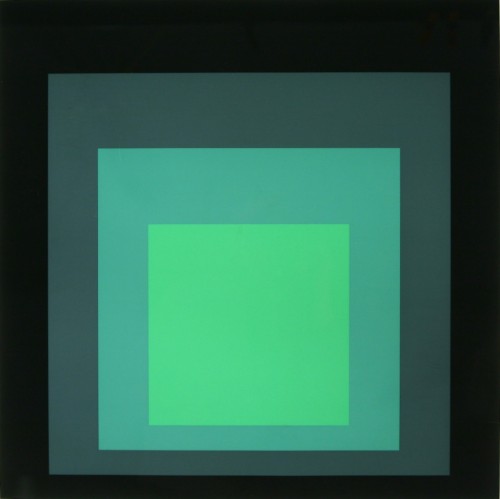
Josef Albers
“My German engineer very argumentative & tiresome. He wouldn’t admit that it was certain that there not a rhinoceros in the room…{He} came back and argued all the time I was dressing.”
Bertrand Russell, letter to Lady Ottoline Morrell, describing first meeting
with Ludwig Wittgenstein(who he later learned was Austrian).
The problem is deciding what accuracy means. Novels are not meant to be science. By the end of the 19th century, the Western psyche had, I believe, completely shaped itself in the image of the novels of that previous hundred years: Tolstoy, Dickens, Henry James, Stendahl, Flaubert, Thackery, et al.(and vice versa, but the important aspect is the former). Nothing much has changed, really, since that imprint. Now, there is no Dickens without Shakespeare and the King James Bible, and Richardson and Fielding, and no doubt Swift. The tentacles of storytelling go back at least to Vedic India, three thousand years, or more. But the idea of a contained story that makes clear it is not meant to be trusted as factual, that solidified around the early 1800s. Today in most book stores you will find a section labled “Non Fiction”. That speaks to the primacy of the idea of making things up being the first role of writing. These are all general observations, because what seems fascinating today is that these novelistic flourishes are now the basic building blocks of official government life. It has other names, spin for one, PR, and there is a lot of discussion suddenly that recognizes the rise of the marketing world and its extensive influence. But, the fact remains, the intentionally novelistic was more associated with, say, Thackery, or Dickens, than later with Dostoyevsky or Herman Broch, or later still in Kafka and Bernhard. To read Bernhard, for example, is to know that this is a voice that will not accept ideas of inaccuracy, or frivolity. The truth is accurate. Bernhard is accurate. Broch is, too, and so is Musil I think, and so forth. Kafka is so accurate it must have been unbearable for him. But what does that mean, exactly? Accuracy is a relatively recent term.
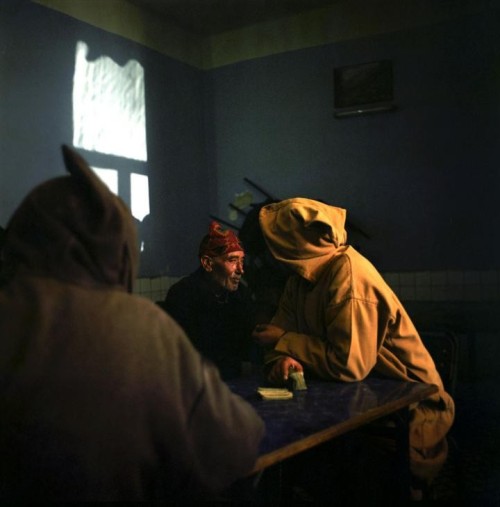
Denis Dailleux, photography. ‘Egypt”.
“From Latin accuratus “prepared with care, exact, elaborate,” past participle of accurare “take care of,” from ad- “to” (see ad- ) + curare “take care of” (see cure ).”
Accurate in the Oxford English Dictionary means correct in all details. In the U.S., it means pretty much the same, but also meticulous and careful. This word wasn’t used until the mid 1600s. I mention all this because it is used today far more often than *truth*.
“(a archaic : fidelity, constancy).
b : sincerity in action, character, and utterance, the state of being the case. Fact (2) : the body of real things, events, and facts : actuality. A judgment, proposition, or idea that is true or accepted as true
The truth comes from a Middle English word meaning constancy, or fidelity. And in Old English, *trēowe* means faithful. Now I find this quite fascinating, its that nerd side of me. Accurate is a word from the instrumental age. Truth is a word that comes from an age that valued constancy, and fidelity. *Constancy* came into use in the 15th century, and was used to mean fixidness, or the character of something unchanging. Today, the lifespan of facts or the truth is shrinking (as David Shields puts it) and I’d add, not only shrinking, but it is less believed. Today, scientists reside in a small corner of the planet, and they do calculations and the measure things. Doctors, physicists, geologists, biologists, etc. And then there is everyone else, who seem to believe in less and less. The only truth now is bureaucratic, administrative, or data based. The data age. The fixidness of both ideas and beliefs in those ideas, has disappeared from the contemporary life. One feels that people, in general, deal with quantifications, with administrative rules and regulations. The age of regulations. They do not explore the nature of meaning. One sees this in psychiatry, where madness is seen as resulting from chemical imbalances. Measure the ingredients, and you can cook up sanity. Or at least docility. The meaning of madness retreats. It is in fact not even a question you hear raised very often.

Ezra Stoller, photography. ‘IBM 702’; apprx 1955.
This belief in regulations and rules and administrative acumen is increasingly in the service of authoritarian state policing of daily life. In fiction, the modernist novel arrived, by the second half of the 20th century, in a sort of expressive cul de sac. This corresponded to a kind of post modern theory that created an imaginary realm that was called various things, among them a *subject position*. The implication, in a backhanded sort of way, was that this imaginary realm was in juxtaposition to something that actually was *real*. In fact all narrative is at least partly looking to make sense of the world around us. The idea of description took hold, and this goes back to Homer really, and such description felt like a sort of mental sign post from which secondary issues of reality could be explored. In truth its all ephemeral and mostly illusory. Still, narratives persist, and its possible that the post modern trend toward the blurring of genres, the treatment of realism as all a matter of perspective, has lost sight of the fact that all literature has always been something more than just documenting reality. And something less. Moby Dick is not a realistic novel. There is nothing written, not novels, or scientific papers, or inventory spread sheets that are, upon close enough examination, really true. Nothing is really accurate either. Not really. The limits of science should now be obvious. But within the relatively narrow project of *science*, the information is at least in a limited way reliable. That was the achievement of the Enlightenment.

Cave paintings, Altimira, Spain. Paleolithic period.
Now, other cultures have made very different uses of the idea of stories. In the West, one of the things that fiction did was to remind the reader that he or she was an invention. The idea of identity was something one created. The police state, in justifying its desire to control the populace, emphasized *identity* as a bedrock fact. It allowed for guilt and innocence. Hence, the manufacturing of a whole pseudo science of forensic study that *proved* this person, this identity, was guilty. Surveillance does the same, and it too is based on a lot of pseudo science. This distorted inheritance of Roman law has been deformed into a giant apparatus of policing.
Now, it has struck me recently that in the post modern age, where truth and reliability seem so mutable, and as a result of two hundred years of focusing on details, on facts, on clues, that something else has arisen, a sense of a *voice*. This is also the result of marketing and advertising. Who is speaking? In advertisements, or commercials, the *voice* presenting things is often never seen. Ad copy almost never identifies whose voice is speaking. The recent faux left project Salvage, pitches its product with copy that reads “Hope is precious, it must be rationed”. Whose voice is that? Well, it is an ad copy voice. And there is, as a friend of mine put is, ‘a violent aristocratism to it’. Indeed, it is superior sounding, and I suspect it is meant to be. For embedded in all advertising is a kind of mild authoritarianism. Just as some ad campaigns work off a mild anti authoritarian tone, as camouflage for the goal of seduction and manipulation. One might wonder at radical political projects resorting to this, but perhaps it just proves its not radical.

Sam Laughlin, photography.
Andre Leroi-Gourhan maintains, in his excellent books on early humans, that the first figurative art was linked to language and was closer to writing than what is understood as art. As he put it; “It was symbolic transposition, not copying of reality…”. If this is so, and I find this pretty convincing (maybe because it supports my intuition about early cave drawings)then those early cave drawings and paintings are closer to a descriptive teaching aid of a long lost oral system.
For Leroi-Gourhan all art is utilitarian to some degree. But it is important to understand what is meant by this. It is utilitarian insomuch as art is somehow linked to our biology, and certainly to the long extremely slow evolution of human community, and to the glacier slow evolution of mimetic function, to hand eye coordination, and to language and text. Writing down the simplest tally sheet, for early humans was aesthetic, it figurative behavior, and it was both individual and collective. The choice of intensity in line, the rhythms, the contrasts, all this is creative, and creativity is a building block of freedom. The removal of creativity is always an aspect of domination. To dominate others is to stop choices, even in how one moves. I wonder at times if what I sense of the loss of creativity and imagination in children (in the West) today is not linked to the inherent prohibitions of technology? For the technologically reproduced image disconnects the human from his gesture, from figurative behavior, from chance and sensory learning. In any event, one of the problems with much contemporary art is not just the craven financial concerns, but more it is with the erosion of social rituals, of myth, and the alienation of artists from a sense of purpose beyond career. The evolution of an idea of *realism* is complex, but it probably represented to early man only one branch of aesthetic expression. In some cave paintings, the late Magdelenian work for example, there is great accuracy. Whoever the artists were, they were trying to copy what they saw, down to details that would have required careful examination. But in other work, there is an early schematization practiced, and a sense, in places, of the birth of a purely decorative impulse. Blank spaces are being filled to, well, fill in blank spaces. Or the decorating of tools, and weapons. Decoration arrived relatively late, however, a few thousand years after the slow evolution of realistic depictions, which in almost all cases, seemed to grow in sophistication as time passed. People were thinking about the marks they made. It is inconceivable that early man did not make music and sing. And dance.
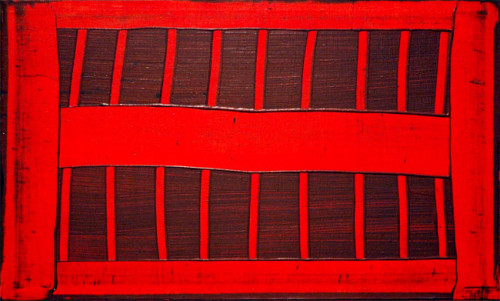
Mary Heilman
There is still, when thinking in terms of human cognitive development, as community, a very long period of time about which nobody knows much of anything. The world was a dark hostile place. It is hard to imagine what went on the mind of those artists paintings the ceilings and walls at Altimira, Lascaux, or Borneo. Still, it is impossible not to believe they contemplated deeply about they were doing. The complexity is startling, at least to me, every time I return to it.
It is also very likely that the contemplation of line and eventually something like composition was reflected in an increasingly complexity in language. And there is wide disparity in the way things developed in different regions. In Eurasian findings there is a curious attention to depth, to a fantastic element in shifting depths of field. In South America animals were stylized, and used in contrast with unexpected elements of decor. This is in slighter later periods, though. The representations of phallus and vulva are never …so far found anyway…in copulation. No Paleo porn. But clearly conception was seen as a transcendent mystery, and one to be revered. But, it is too easy to impose a cheap religio-mystic narrative on these early cave drawings and figurines. The narratives that do exist, in the later Paleolithic art are singular. One event, or so it appears. Leroi-Gourhan suggests that the inexplicable nature of much cave painting is because something else, some meaning outside the purely optical, is at work. In this sense, he says, it resembles 20th century abstraction. It is what mimesis is, in a sense, and it is that primordial impulse to scratch a surface. Very young children playing by streams will always get around to making some kind of temporary dam. I leave my mark on the waters. The course of the stream is altered, because of me, if only for five minutes. It is proof, or verification, that ‘I am’. For those cave dwelling artists, most of their world was unknown. Was unknown in a way that contemporary man cannot grasp at all. The nights were dark, and threatening. Most of these tribes, those who drew on cave walls, were existing in isolation. How much isolation isn’t, again, really known. So, what did they speak of to each other? Why did they speak when they did speak. We have no idea of such questions, today. Whatever they drew must indeed have been related to some idea of the unknowingness of the world. It may have been a dialectical process of creating a language, of pictograms and mythograms, but it was certainly not a religion as people know of that today. The depth was of another order.
“The gesture of the savage who pauses for an instant to reflect whether or not he wishes to eat his prisoner contains teleogically the end of violence.”
Adorno

Raine Karp, architect. Tallin, Estonia 1975. Photo by Jarmo Kauge.
“Leroi-Gourhan stressed the social nature of memory in human societies.
Memory is not the property of the individual but rather of the collective members of
society. Thus, to say that gesture is concrete and individual presents only one side of the
coin. While this is true, it is equally true that gesture is necessarily collective and abstract
in the sense that gesture involves not only the movement of the body but also the
knowledge that structures this movement.”
Michael Chazen
To return to contemporary magical thought; where so deeply internalized are ideas of authority and control, where identity is linked directly to paperwork, to verification, there is a logic to that primordial impulse for meaning finding its way to an outlet that deforms and impairs it irrevocably. Creativity is then infantilized in science fiction, fantasy stories, and nostalgic tales of feudal romance. The popularity of all these forms is understandable, for it offers up an acceptable space for the pretense of meaning outside conventional daily conformity.

Tony Tuckson
Of course, that pretense is only that. Its an illusion. Game of Thrones is precisely the sort of adolescent mock-up of real drama that American audiences can tolerate. Gosh, it’s sort of just like Shakespeare, except I can understand it and there are more breasts. The entire sci-fi culture is one of stunted emotional development. It is another of these illusory outlets for aesthetic abridgement. This is a whole topic deserving of an entire posting, but the short version is that in an age when almost everything is genre, the insistence upon genre forms, often carefully outlined, is regressive. But… magical thinking then. The case of the Boston Marathon Bombing is a perfect case in point. For this is how the neo-Police State operates. The Tamerlan Tsarnaev case is a study in now the deep state operates and its the same sordid and morally toxic cesspool it has always been.
http://dissenter.firedoglake.com/2015/04/26/podcast-questions-that-should-be-answered-about-fbis-conduct-before-after-boston-bombings/
The high tech squeaky clean cadre of square jawed crime fighters one sees on various cop shows is pure fantasy, pure projection. What exists in reality are the underfunded PD’s, the dirty and crumbling city holding tanks for the accused waiting for their usually redundant court appearance, and the stale bread and plastic cheese sandwiches fed to them…maybe. Everywhere and everything is overcrowded and derelict. And it is the privatized prison system and the endless guard brutality, sadism, torture and humiliation of correctional facilities from county to federal level. And cop culture is one of absolute corruption on all levels. From the DA’s offices in every single U.S. city, to the patrolmen and beat cops; the mentality is one that expects bribes, panders to the rich and powerful to get said bribes, and it is the continuation of constant exercising of sadism. That national figures show police officers beat their wives at twice the national average is hardly surprising. The population today is largely one that believes in a system that they know is cheating them. I notice that there is in Western society today a fascination with proxy forms of work. Young men like to tinker with motorcycles or weapons, or DIY building projects. Leisure time is taken up with imitations of work, but they feel as if they were freely chosen, hence owned. It must be clear by now that technology developed along lines determined by the ruling class. All that the working class can own today are facsimile versions of their own domination.
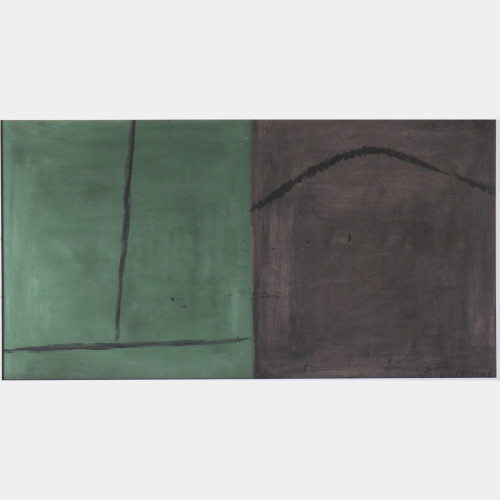
Ma Kelu
So, the new magical thinking is useful to look at in terms of those Paleolithic artists. One of the values of reading Wittgenstein is that is makes one aware of how language mediates reality. By which I mean, or think I mean, that if those cave painters were engaged in a process of concretizing language, of both mimetic attention to sensory experience, and to this mysterious tool of communication, to the creation of both text and art, they were discovering the very idea of ‘meaning’. And I think Leroi-Gourhan is right that those cave paintings meant more than what they show. For this is how abstraction works. This is what abstraction is.
Today, magical thinking is convenient in the sense that verification is the principle for government control of individuals. The problem for this system is that verification requires the removal of the human. Nothing is as faulty as our memory. Our memory, both individual, and collective (or social) is faulty. We don’t remember things *accurately*. Jonathan Crary wrote, in speaking of early photography, and specifically about Edward Muybridge; “The segmentation of Muybridge’s work should be understood not simply as the break-up of a perceptual field but also as the claiming of an instantaneity of vision from which space is deleted. It announces a vision compatible with the smooth surface of a global marketplace and its new pathways of exchange.” Constancy, the truth, is inimical to Capitalism. Verification had to intercede in a sense, and remove constancy from the human. The machine was impersonal, and hence could be trusted. Siegfried Krakauer (quoted by Crary) suggested that photography quickly became the benchmark for historiography. The bogus forensics of today’s criminal justice system is just another degree removed from this late 19th century shift of trust to technology. The subject position of the camera is much like the subject position of the ad copy voice. This is the floating signifier, insofar as there is no subject behind the perspective of the camera. There is what Crary called the *reality effect*.
“…the ungroundedness and mutable temporality of these images would be integral to the modern production of a pervasive historical amnesia.”
Jonathan Crary
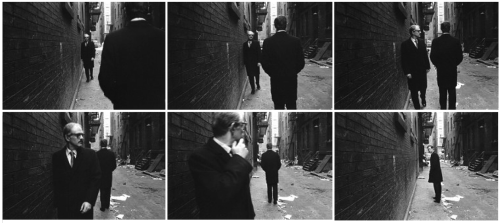
Duane Michaels, photography.
Photographs arose at the same time as other advances in optical technology, like the microscope. The unseen was now visible. I’ve written of this before; the rise of detective fiction coincided with an ability to discover visually hidden clues. Today, the magical thought of the criminal justice system is the logical end game for that late 19th century belief in the facticity of optical technology. Photography is of course also connected to ideas of memory. They evoke memories. So, there was a double edged affect in play, for memory is faulty, and technology is not. The technology won that debate, in a sense. Memory was now, in administrative and legal terms, reliable. The ‘eyewitness account’. The first hand account claimed authority. There is really no good reason for this claim, but it has persisted nonetheless. Legally, the eye-witness became a camera.

Ann Veronica Janssens
“At the outset, the concept of hereditary, biochemical error rested on the ingenuity of a metaphor; today it is based on the solidity of an analogy. Insofar as the fundamental concepts of the biochemistry of amino acids and macromolecules are concepts borrowed from information theory, such as code or message; and insofar as the structures of the matter of life are linear structures, the negative of order is inversion, the negative of sequence is confusion, and the substitution of one arrangement for another is error. Health is genetic and enzymatic correction. To be sick is to have been made false, not in the sense of a false bank note or a false friend, but in the sense of a false fold {i.e. wrinkle – faux pli} or a false rhyme.”
Georges Canguilhem
The Normal and the Pathological
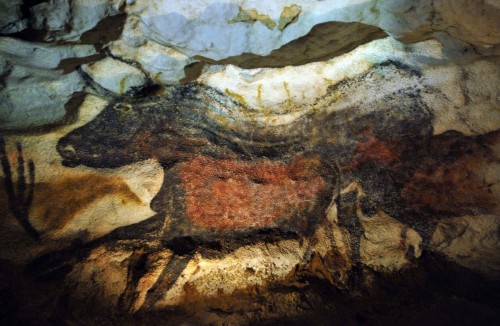
Lascaux caves.
Sickness then, is error. Information theory, and there is a curious masochism involved in all this, too. The human cannot ever be without error. So the mediated health of the *healthy* means those with errors that Capital can live with.
“I want to play chess, and a man gives the white king a paper crown, leaving the use of the piece unaltered, but telling me that the crown has a meaning to him in the game, which he can’t express by rules. I say: ‘as long as it doesn’t alter the use of the piece, it hasn’t what I would call a meaning.'”
Wittgenstein
The Blue Book
It strikes me that a good deal of today’s theory, post modern theory, results in the sort of pseudo science the state employs in forensics, and it does this by putting paper crowns on various concepts and telling everyone that they have meaning.
There is a strange reality to the West today, to the living in boxes. I say this as someone who actually admires a lot of brutalist architecture. But the accumulation of boxes is now becoming a kind of living metaphor.
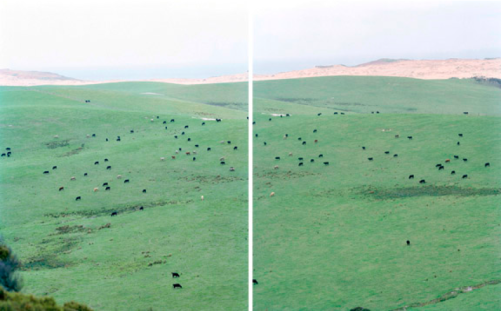
Walter Nieddermayr, photography.
The cave painters of Altimira formed marks in an ongoing project of both communication (language), or text, and of behavior that helped define themselves, both individually and as a community, and as ritual selves. Lascaux must have been a relatively large community. In Indonesia, the even earlier drawings are more damaged, but the hands in silhouette are indentical to those in France, and in Argentina. Perhaps a few thousand years, at most, separate all of these artists. What does this suggest? Earlier, probably African groups, migrated. Dispersed…but that far? The hand, that which holds the tools, the implements for paintings, for hunting, for building. The hand must be represented. It is a hand held to the wall, and nearly the same red/ochre pigment is blown around it. Is there a *rational* explanation? Perhaps. I find my brains begins to both freeze and open as I look at this art. One want’s to ask: who were they? Who painted that? Man, woman, and why? The *why* is not a real question, though. They did. And all over the globe, throughout the world..and no doubt more caves will be discovered. Nothing is really known. Nothing. They painted an enormous amount, as well. These are not a few odd splotches of pigment on the occasional random wall. These are huge grand creations. There is no way to know what they might have created outside those caves. What they painted in sunlight. That would all be gone. The Vedic culture in what is now India, a mere three thousand years ago, are as mysterious to us, almost, as the Paleolithic society(s). But we feel we know them because we have their texts. That makes them seem more modern, more like us. I doubt they were.
All that is really known is that a semi nomadic people crossed the mountains of Central Asia, from Iran (likely) and into the subcontinent of India. They worshiped fire, like Zoorastrians, and they took *Soma*, a hallucinogen. Their language evolved over time into the language of the Vedas, an Indo-European variant. They left a written record of a complex oral narrative; The Vedas. Part story, part philosophy, part poem. There is no trace of a Vedic city, no monuments. Only the Vedas. Roberto Calasso’s remarkable book Ardor, is a long contemplation of who they might have been, and of the texts. “He who knows thus” is a repeating ritual incantation in the Vedas. The one thing that seems clear is that the Vedic people were focused on ‘awareness’. I think they hold a certain spell over contemporary people because they are so different. Awareness, not war, not conquest, not hording. So, the sadness I feel, often, surveying contemporary life is linked to thoughts of Paleolithic artists, to Vedic thinkers and storytellers, to all the people who seemed to live in at least relative stability, and many of them exterminated. Native American tribes, all 600 of them, or the Tasmanian people, all gone now, or in what is now Canada, the Beothuk people, utterly wiped out. There are too many examples to really list; the Herero and Namaqua, the Jivaro, or the Ache who were wiped out in Paraguay by General Stroessner, or the Mbuti, and on and on. It seems difficult to understand how such massive violence goes so unnoticed in contemporary life. So *not* remembered. I do not think people are born innocent, and I think strife and rivalry form a part of of what it is to be human. But it is doubtful any society in history has been as without *awareness* as modern western societies. The contemporary societies of the West have perfected a kind of industrial level violence and irrational lust for conquest, and a fetid clenched jaw blindness that has no rival in history. It is the culmination of something that went very wrong.

Freud described the narcissist’s belief in the thaumaturgic force of his own thoughts: I think it’s interesting to see that regression to omnipotent phantasy, secondary narcissism, completed not in a withdrawal from the conditions an affectless and mundane world, but in the alignment of ego-libido with the mechanisms of power inherent in their reproduction. It reminds me of Ferenczi’s work on the fairy tale, the pleasant fantasy of donning a cape and becoming invisible, or the magic wand to ward off monsters — the narcissistic roots of these seductive narratives — that this regression is accomplished now by the infantilised adult in contemporary society in the surrender of psychical freedom to the apparatus of control. (Was curious to read a post of yours that didn’t mention Freud, stirred up some reflections from me!)
Its funny Oisin, as I was thinking of Freud while writing this, especially about photography and memory. What you just articulated is exactly right I think. The alignment with power and authority. There is some kind of hyper super ego formation that identifies with authority and aggression — as a default setting I think. This identification allows for an acceptance of all violence — but from the side of most power. Its why so much of the empty rhetoric of post mod theory , which grants permission to be the aggressor….is popular. And especially I think in the fantasy narratives that seem to be everywhere now. There is obviously much more to say about all this.
And of course Freud’s concept of the super-ego developed from his study of narcissism: the attendant harsh inner voice that measures the actual ego in comparison to an ego-ideal. In a sense it’s the most primary regression, and yet one facilitated most readily by present conditions, violent and oppressive and the embodiment of omnipotent phantasy. I am always interested to read your application of these ideas to questions of theory. As a brief reflection on studying psychoanalysis this past year, a recurrent theme, or line of argumentation, in the class environment from my fellow students is the ineffability, or transience of meaning, of all ideas or theories or connections, with the general and almost universal exception of the diagnostic category. Your comments on this strange paradox of scientific “knowledge” vs. the erasure of all else ring true.
It curious, but what you describe in class feels like the application of this sort of appropriation and distortion of Lacan. It feels as if nobody is more misread than Lacan. But for sure there is some sort of closed feed back loop in how present conditions have reinforced and encouraged this hyper vigilant super ego — one that is almost sort of on auto pilot….to be very un-theoretical. Also, how this new version of repressive de sublimation has created this weirdly malignant sexual infantilisim, too.
“The new and remarkable fact that we must now describe is that the repetition compulsion also brings back those past experiences which include no possibility of pleasure and which even then could never have brought satisfaction, not even of drive-impulses that have since been repressed.”
Beyond the Pleasure Principle.
This was in speaking about transference. It was this contradiction in a sense….the power of the repressed material. But all repression was in theory about pleasure, so this resistance to the analyst’s desire is, in a sense, what is beyond the pleasure principle. So repetition was both a result of repression, but also of…so he seemed later to suggest….but of some form of isolation. (thats samuel weber’s take anyway). I think there is something in this idea of isolation …but he only scratched the surface and today this is perhaps a more acute and altered phenomenon.
This is fascinating and valuable, as always. This is by far the best aesthetics related blog I am aware of. One of my favorite quotes from Sun Ra, which is from an interview with Francis Davis, I believe:
Have you seen Star Wars? It’s very accurate.
These essays penetrating the illusions of modern life, of capitalism, of the decay of a human society into a miasma of money and machines, to expose the heart of things should be published as a collection one day. Wittgenstein said “we make to ourselves pictures of facts” and you have succeeded in doing just that; presenting the reality of modern life in images that reveal its true meaning. Their is a limit to the expression of thoughts, as he also said, but you keep pushing those limits. Glad someone is.